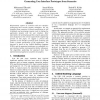FORMATS
2007
Springer
14 years 7 months ago
2007
Springer
Resource limited DRE (Distributed Real-time Embedded) systems can benefit greatly from dynamic adaptation of system parameters. We propose a novel approach that employs iterative t...
CAISE
1997
Springer
14 years 7 months ago
1997
Springer
OO-Method is an OO Methodology that blends the use of formal specification systems with conventional OO methodologies based on practice. In contrast to other approaches in this fi...
WIFT
1998
IEEE
14 years 7 months ago
1998
IEEE
In this paper I examine what industry really needs from formal specification techniques. I first describe the background to our use of formal techniques. I then look at the role o...
RE
1999
Springer
14 years 7 months ago
1999
Springer
Requirements capture by scenarios and user interface prototyping have become popular techniques. Yet, the transition from scenarios to formal specifications is still ill-defined, ...
PRIMA
2001
Springer
14 years 7 months ago
2001
Springer
One of the most appealing features of multiagent technology is its natural way to modularise a complex system in terms of multiple, interacting and autonomous components. As a natu...
RSP
2005
IEEE
14 years 8 months ago
2005
IEEE
For cost-effective prototyping, system designers should have a clear understanding of the intended use of the prototype under development. This paper describes a classification of...
IAT
2006
IEEE
14 years 9 months ago
2006
IEEE
In this paper a cognitive model for visual attention is introduced. The cognitive model is part of the design of a software agent that supports a naval warfare officer in its task...
ICDE
2007
IEEE
14 years 9 months ago
2007
IEEE
The correct implementation of security protocols is a challenging task. To achieve a high degree of confidence in an implementation, as with any software, ideally one requires bot...
ICSE
2008
IEEE-ACM
15 years 3 months ago
2008
IEEE-ACM
Software Testing can take up to half of the resources of the development of new software. Although there has been a lot of work on automating the testing phase, fixing a bug after...
DAC
2006
ACM
15 years 4 months ago
2006
ACM
Formal languages are increasingly used to describe the functional requirements (specifications) of circuits. These requirements are used as a means to communicate design intent an...

